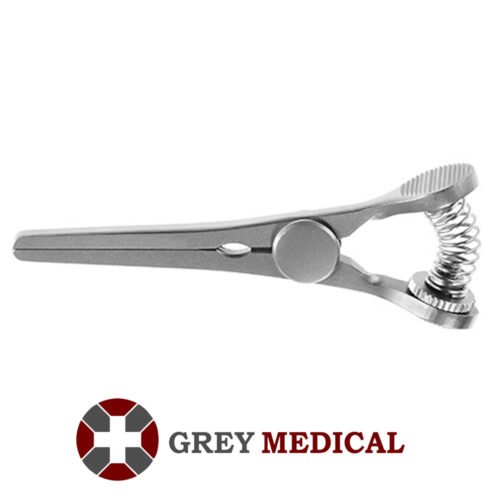Vascular clamps are indispensable instruments in vascular surgery, designed to control blood flow in arteries and veins during surgical procedures. These specialized clamps are critical for maintaining a bloodless field, preventing hemorrhage, and ensuring the surgeon can work with precision and safety. The unique design and functionality of vascular clamps make them a crucial component in the success of various vascular interventions.
Design and Features of Vascular Clamps
Vascular clamps are meticulously designed to apply controlled pressure to blood vessels without causing damage. They are typically crafted from high-grade stainless steel or other durable, biocompatible materials that can withstand repeated sterilization. The jaws of these clamps are carefully contoured and often have a soft, atraumatic surface to minimize tissue injury. Some models include serrated or grooved jaws to provide a firm grip on the vessel, reducing the risk of slippage during the procedure.
The handles of vascular clamps are ergonomically designed to provide surgeons with maximum control and comfort. Many clamps have locking mechanisms, such as ratchets, to secure the clamp in place, freeing the surgeon’s hands to perform other tasks. The clamps come in various sizes and shapes to accommodate different types of vessels and surgical scenarios, ranging from small, delicate arteries to larger veins.
Types of Vascular Clamps
There are several types of vascular clamps, each tailored to specific surgical needs. Bulldog clamps are small, spring-loaded clamps used to temporarily occlude blood flow in smaller vessels. Their compact design allows for precise application in tight spaces.
Satinsky clamps are designed for partial occlusion of large vessels, such as the vena cava. Their curved jaws enable the surgeon to control blood flow without completely cutting off circulation, which is essential in procedures like aneurysm repair or organ transplantation.
DeBakey vascular clamps, named after the renowned cardiovascular surgeon Michael DeBakey, are versatile and widely used in a variety of vascular surgeries. These clamps are long and slender, with fine serrations that provide a gentle yet secure grip on blood vessels.
Cooley clamps are another popular type, featuring a similar design to DeBakey clamps but with a more pronounced curve, allowing for better access in certain anatomical areas. Both DeBakey and Cooley clamps are essential in cardiac and thoracic surgeries, where precise control of blood flow is critical.
Applications in Surgical Procedures
Vascular clamps are used in a wide range of procedures, from minimally invasive surgeries to complex open surgeries. In coronary artery bypass grafting (CABG), vascular clamps are used to occlude the coronary arteries while the surgeon creates a bypass. During aneurysm repair, clamps control blood flow to prevent rupture and allow the surgeon to safely place a graft.
In organ transplantation, vascular clamps play a pivotal role in controlling blood flow to and from the transplanted organ. They ensure that the surgical site remains dry and that the organ is properly perfused once anastomosis is completed.
Vascular clamps are also vital in trauma surgery, where quick and effective control of bleeding can be life-saving. In cases of traumatic injury to blood vessels, clamps are used to stabilize the patient and prevent exsanguination while repairs are made.
Importance of Precision and Safety
The precision of vascular clamps is crucial in preventing complications such as vessel damage, thrombosis, or ischemia. The gentle yet firm grip of these clamps ensures that blood flow is controlled without crushing the vessel, which could lead to long-term vascular complications. Surgeons rely on the high-quality construction and reliability of vascular clamps to perform delicate maneuvers with confidence.
The safety provided by vascular clamps extends to the overall success of the procedure. By maintaining a clear and controlled surgical field, vascular clamps reduce the risk of infection and improve visibility, allowing the surgeon to work more efficiently. This is particularly important in lengthy or complex surgeries where precision is paramount.
Innovations and Advancements
Advancements in vascular clamp technology have focused on enhancing the safety and efficiency of these instruments. Innovations include the development of non-stick coatings that prevent blood and tissue from adhering to the clamp, making it easier to reposition and reducing the risk of damage upon removal. Some modern clamps are designed with radiopaque materials, allowing for better visualization under imaging techniques, which is particularly useful in minimally invasive procedures.
Additionally, disposable vascular clamps have been introduced to minimize the risk of cross-contamination and ensure sterility. These single-use clamps offer the same level of precision and reliability as their reusable counterparts, making them a valuable option in certain surgical settings.
Conclusion
Vascular clamps are a cornerstone of vascular surgery, providing surgeons with the tools they need to manage blood flow with precision and safety. Their diverse designs and applications underscore their importance in a wide range of procedures, from life-saving trauma surgeries to complex cardiac operations. As technology continues to advance, the role of vascular clamps will remain integral, supporting surgeons in delivering optimal patient outcomes and advancing the field of vascular surgery.
